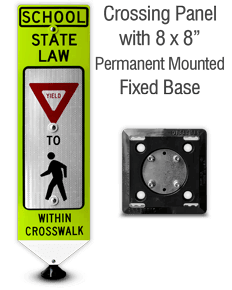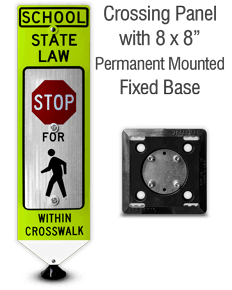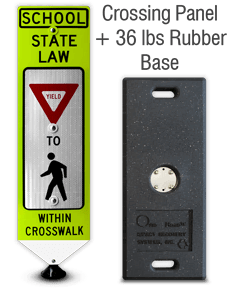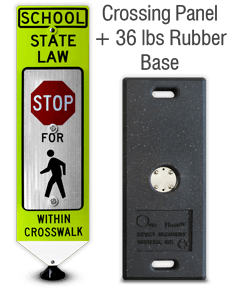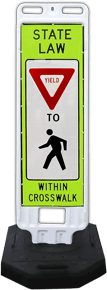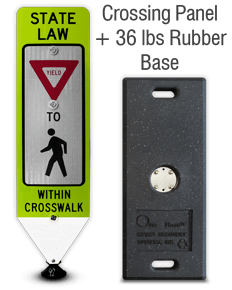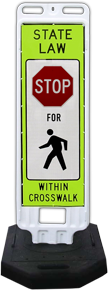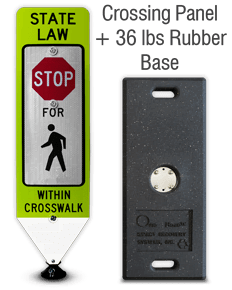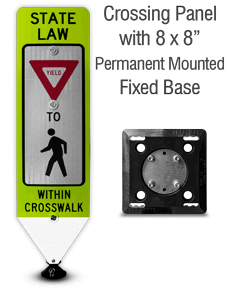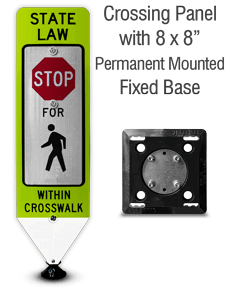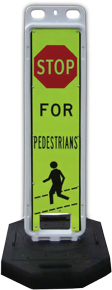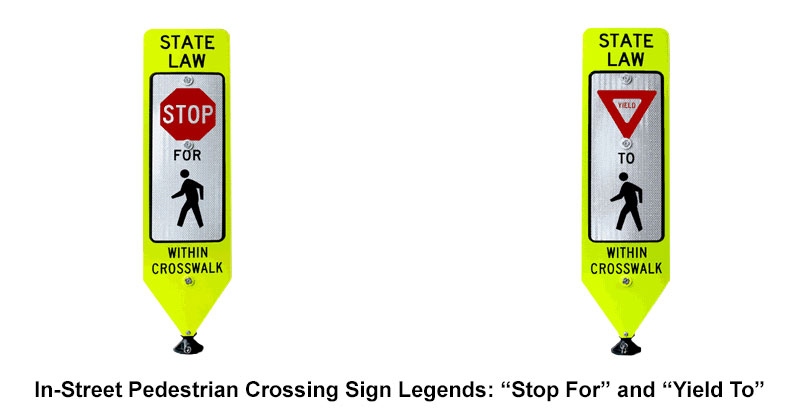Which In-street Crossing Sign Do I Need?
In-street crosswalk signs can be installed to increase the visibility of a crosswalk and to give drivers more warning where they will need to yield or stop for pedestrians in the crosswalk.
While the name of "in-street crosswalk signs" might give you a clue as to where these signs are posted, there are still specific rules set by the Federal Highway Administration (FHWA) as to where these signs should be installed.
From the standard in the FHWA’s Manual on Uniform Traffic Control Devices (MUTCD) Section 2B.12 In-Street and Overhead Pedestrian Crossing Signs:
"If used, the In-Street Pedestrian Crossing sign shall be placed in the roadway at the crosswalk location on the center line, on a lane line, or on a median island. The In-Street Pedestrian Crossing sign shall not be post-mounted on the left-hand or right-hand side of the roadway."
"The In-Street Pedestrian Crossing sign and the Overhead Pedestrian Crossing sign shall not be used at signalized locations."
There are two types of in-street crosswalk signs: "yield to" and "stop for" signs. Each type has a legend that alerts drivers to the state law requiring vehicles to either yield or stop at crosswalks.
"The STOP FOR legend shall only be used in States where the State law specifically requires that a driver must stop for a pedestrian in a crosswalk." (MUTCD Section 2B.12)
There are also versions of these crossing signs specifically for school zones, with "School" outlined and added to the sign legend above "State Law."
The following table represents the most recent information available online related to state laws regarding in-street pedestrian crosswalk signs. Each state may have additional and/or more accurate information available to its residents through its government offices, websites, and other resources. SafetySign.com cannot guarantee the accuracy of these specific regulations, and strongly recommends the end user of in-street pedestrian crossing signs to check official sources before purchasing and installing these signs.
-
State "Yield To" or "Stop For" Signs Reads: State Law Reads: School State Law Alabama Yield To Y4933 Y4939 Alaska Yield To Y4933 Y4939 Arizona Yield To Y4933 Y4939 Arkansas Yield To Y4933 Y4939 California Yield To Y4933 Y4939 Colorado Yield To Y4933 Y4939 Connecticut Yield To Y4933 Y4939 Delaware Yield To Y4933 Y4939 Florida Stop For Y4934 Y4940 Georgia Stop For Y4934 Y4940 Hawaii Stop For Y4934 Y4940 Idaho Yield To Y4933 Y4939 Illinois Stop For Y4934 Y4940 Indiana Yield To Y4933 Y4939 Iowa Yield To Y4933 Y4939 Kansas Yield To Y4933 Y4939 Kentucky Yield To Y4933 Y4939 Louisiana Stop For Y4934 Y4940 Maine Yield To Y4933 Y4939 Maryland Stop For Y4934 Y4940 Massachusetts Yield To Y4933 Y4939 Michigan Yield To Y4933 Y4939 Minnesota Stop For Y4934 Y4940 Mississippi Yield To Y4933 Y4939 Missouri Yield To Y4933 Y4939 Montana Yield To Y4933 Y4939 Nebraska Yield To Y4933 Y4939 Nevada Yield To Y4933 Y4939 New Hampshire Yield To Y4933 Y4939 New Jersey Stop For Y4934 Y4940 New Mexico Yield To Y4933 Y4939 New York Yield To Y4933 Y4939 North Carolina Yield To Y4933 Y4939 North Dakota Yield To Y4933 Y4939 Ohio Yield To Y4933 Y4939 Oklahoma Yield To Y4933 Y4939 Oregon Stop For Y4934 Y4940 Pennsylvania Yield To Y4933 Y4939 Rhode Island Yield To Y4933 Y4939 South Carolina Yield To Y4933 Y4939 South Dakota Yield To Y4933 Y4939 Tennessee Yield To Y4933 Y4939 Texas Yield To Y4933 Y4939 Utah Yield To Y4933 Y4939 Vermont Yield To Y4933 Y4939 Virginia Yield To Y4933 Y4939 Washington Stop For Y4934 Y4940 Washington D.C. Stop For Y4934 Y4940 West Virgina Yield To Y4933 Y4939 Wisconsin Yield To Y4933 Y4939 Wyoming Yield To Y4933 Y4939
With the information from your state government and knowledge of the crosswalk where these signs would be used, in-street crossing signs can be useful and effective safety enhancements for pedestrians. To browse different in-street sign configurations and accessories, visit our in-street crossing signs page.
SafetySign.com does not recommend or specify the use of a specific safety sign because it does not have knowledge of the hazard(s) our customers are identifying. It is the customer’s sole responsibility to identify the hazard(s) that may be present and select one or more signs (stock or custom) that accurately identify their specific hazard(s) and complies with any applicable federal, state or local laws or regulations, any worksite specific rules or regulations and/or any applicable safety standards (including, without limitation, MUTCD standards). SafetySign.com disclaims any and all liability (excluding liability for our Product Warranty contained in our Terms and Conditions) for any sign selected by a customer and shall not be responsible for any personal injury or property damage resulting from the use of signs purchased from it or for the independent interpretation made of any applicable federal, state or local laws or regulations, any worksite specific rules or regulations, and/or any applicable safety standards (including, without limitation, MUTCD standards). Customer shall indemnify and hold SafetySign.com and its corporate parent and its officers, directors and affiliates harmless from and against any and all claims, loss or expense (including attorneys’ fees) arising from or related to the purchase and use by customer or any third party of any sign purchased by customer from SafetySign.com.

